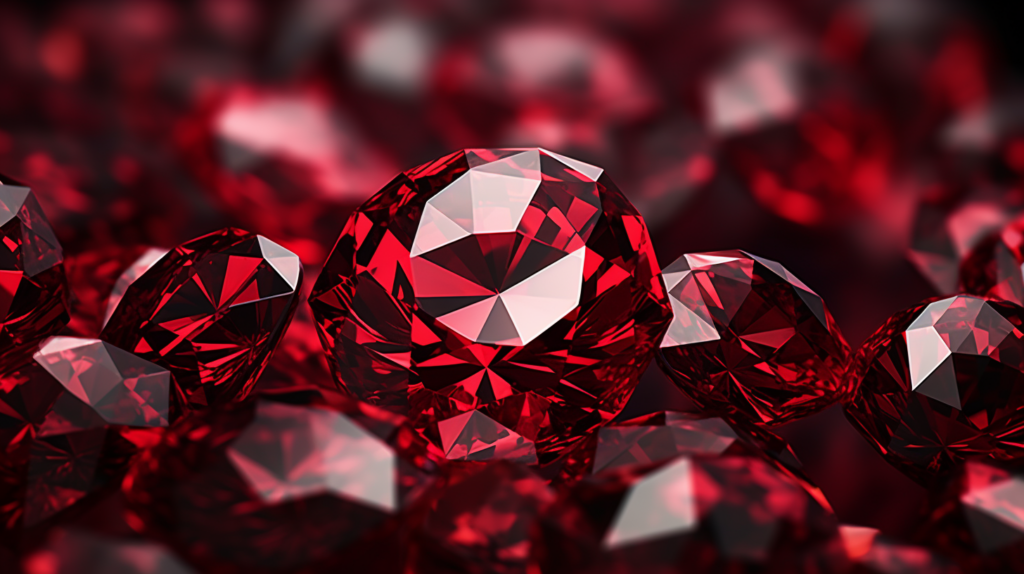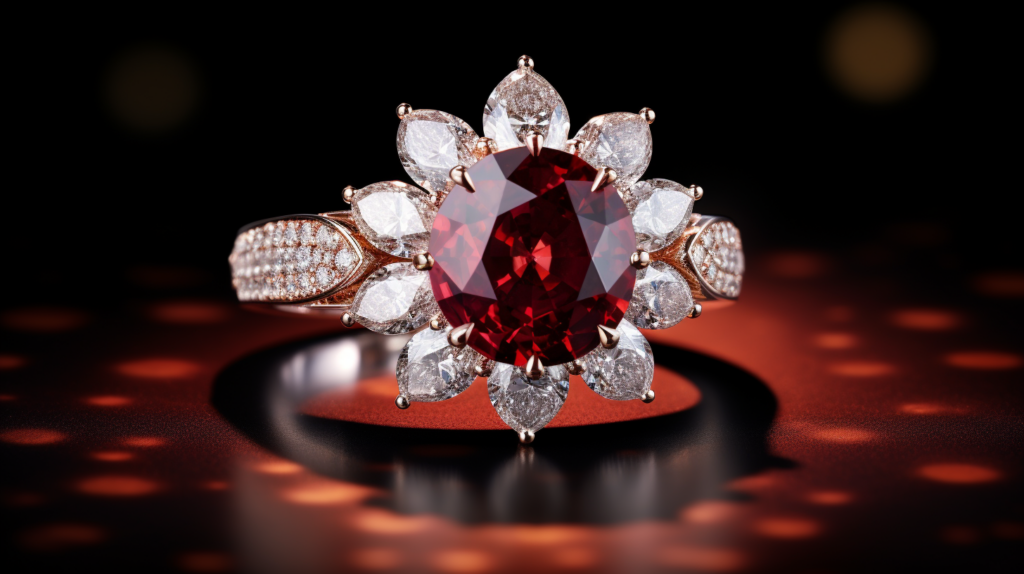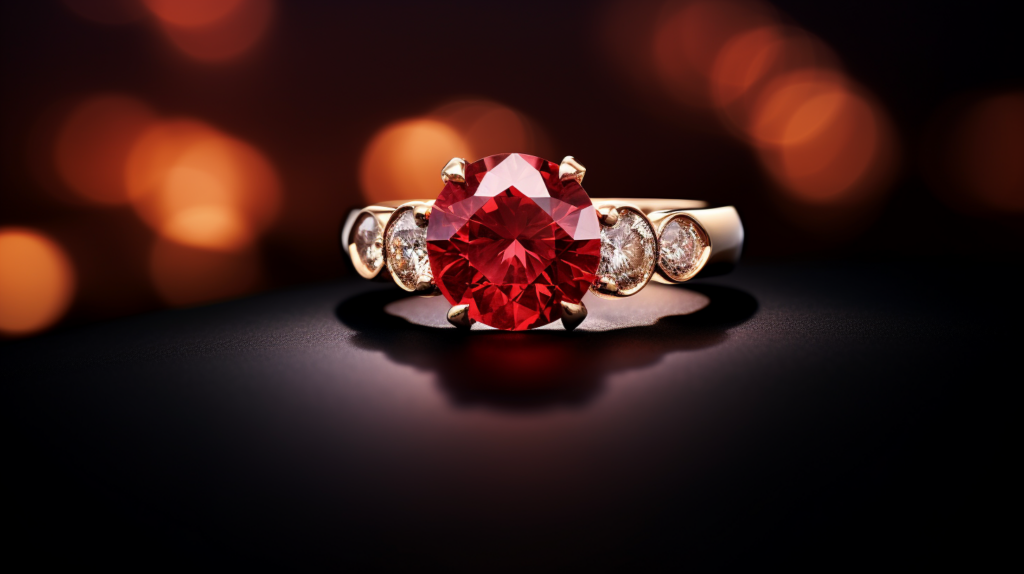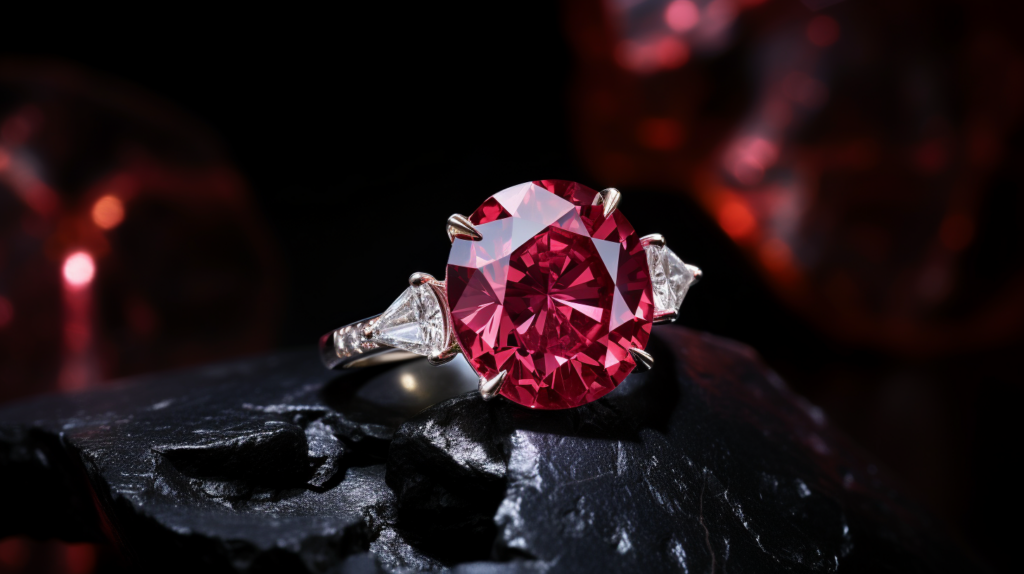Red Diamonds: Welcome to the magical world of red diamonds, where diamond enthusiasts and buyers can get their fix of diamond news. Learn about these rare and intriguing carbon gemstones, a remarkable gemstone among expensive gemstones, together.
In this article, The Fascination of Red Diamonds, Discover the origin, intensity levels, pricing, and stunning jewelry settings of these pure carbon beauties, a compelling message for anyone interested in diamond investment & intelligence.
Red diamonds’ mystique and rarity, a hot topic among fancy color diamond experts and diamond enthusiasts, will captivate you as we explore their universe. This intimate examination by BrighterGuide will reveal the spellbinding beauty and beautiful color of these beautiful crimson gems.
Key Takeaways
- The origin of red diamonds’ color, much like the enigmatic depths of the Blue Nile, remains a mystery, even to diamond professionals. These gems stand out for their unique purity and intense color saturation, setting them apart from other colored diamonds.
- Red diamonds are among the rarest and most expensive gemstones, often fetching over $1 million per carat, with famous examples like the Hancock Red Diamond and the Moussaieff Red Diamond adding to their allure.
- Various settings like prong, halo, and three-stone arrangements can enhance the visual appeal of red diamonds, but due to their rarity and value, expert guidance is recommended when selecting a setting.
Origin of Red Diamond’s Color

We diamond professionals still don’t know why red diamonds are red, making it one of the most intriguing questions in the world of natural diamonds. The cause of their brilliant red color remains unknown despite much investigation and analysis by Gemological Testing Labs and the natural color diamonds community. A popular notion holds that diamonds’ journey to Earth’s surface involves modifications in their atomic structure and arrangement of atoms. Deep in the earth’s mantle, intense pressure and extreme heat generate these diamonds, lending them a unique tint. This can be thought of as a form of plastic deformation affecting their crystal lattice structure.
Red diamonds are pure carbon gemstones, unlike other colored diamonds like blue diamonds, yellow diamonds, or brown diamonds with chemical impurities or nitrogen levels. Their origin is intriguing due to their impurity-free status, making them a real diamond gem in estate jewelry collections. Red diamonds aren’t graded on the same color intensity level as white or colorless diamonds. Instead, red diamonds are supersaturated pink diamonds with strong color saturation.
Another issue is that red diamonds’ UV light or fluorescent light can change their hue. The origin of their color is further complicated by this phenomenon, involving wavelengths of light and the interaction of light with their molecular structure.
What Are Red Diamonds?
Gemologists and specialists always learn more about red diamonds, often through high-end jewelry events.
Fancy color diamonds, particularly red and purple diamonds, are the rarest and most valuable type of diamonds, garnering figures per carat that most other stones can’t match in price per carat. Their rich red to-purple red tint distinguishes these rare diamonds from colored stones like sapphires or rubies, making them remarkable stones with a strong saturation of color.
The Hancock Red Diamond, a 0.95-carat dark purplish red diamond named after Warren Hancock, is famous among expensive diamond circles. The 5.11-carat Moussaieff Red Diamond, owned by Moussaieff Jewelers Ltd. and discovered in the alluvial deposits of Minas Gerais, is the third-largest red diamond in the world and part of their public display.
Rare red diamonds are primarily found in limited places. For example, the Argyle mine in Western Australia, operated by Rio Tinto, produces famous red diamonds that often receive celebrity attention at trading events.
Red diamonds are expensive because of their scarcity and clarity grade, often fetching spectacular prices in dollars per carat. The William Goldberg Diamond Company, a name synonymous with famous diamonds and valuable diamonds, is known for its red diamond jewelry, often seen in natural history museums and articles about diamonds.
Red Diamond Intensity Levels

Unlike other fancy-colored diamonds, red diamonds have no color intensity variation. Red diamonds don’t have an intensity spectrum like other diamonds. Their color intensity and vividness are their trademarks.
Here are four surprising red diamond intensity facts:
1. Supersaturated Color: Red diamonds are supersaturated pink diamonds. Their deep red color distinguishes them from other colored diamonds.
2. Pure Red vs. Secondary Tones: Red diamonds can have purple-red, Brownish, or Orangey overtones. Pure red or purplish red diamonds are worth more than secondary tones.
3. Price Tag: Rare red diamonds are the most expensive colored gems. Pure red diamonds often cost over $1 million per carat weight, making them rare.
4. Rarity and Diamond Value: Red diamonds are rare and valuable. The most rare and expensive are red diamonds without orange or purple tones.
Red diamonds seduce with their rich hue. Collectors and aficionados of exquisite jewelry love its rarity. Red diamonds are beautiful and rare, making them fascinating.
Red Diamond Prices

Let’s review red diamond prices and how they’ve appreciated over time. You can also check the diamond buying guide. Red diamonds are the most expensive colored diamonds due to their scarcity. One-carat fancy red diamond can cost over $1 million, making it one of the most valuable stones.
Red diamond prices depend on carat weight and color intensity. Red is more expensive when saturated and pure. The most valuable and expensive diamonds are red with no secondary tones like orange or purple. Smaller red diamonds, under one carat, are rare and expensive.
Red diamond prices have risen steadily. Rare gemstones increase in value as demand and awareness expand. Collectors and aficionados pay top money for red diamonds. Red diamonds are the epitome of luxury and exclusivity among fancy-colored diamonds due to their rarity, vivid color saturation, and appeal.
Red Diamond Engagement Ring Settings
Red diamond engagement rings can showcase these unusual gemstones in different forms.
The intricate halo setting, which surrounds the red diamond with lesser diamonds, is popular.
In the typical three-stone arrangement, two lesser diamonds flank the red diamond, symbolizing the past, present, and future.
Finally, the prong setting is classic and makes the red diamond sparkle.
Style 1: Ornate halo setting
We love red diamond engagement rings with beautiful halo settings. This approach makes red diamonds look more elegant. Here are four reasons why the elaborate halo setting is ideal for red diamonds:
1. Eye-Catching Contrast: The red diamond’s deep color is highlighted by the halo of lesser diamonds.
2. Sparkling Brilliance: The halo setting’s extra diamonds reflect and enhance light, making the ring dazzle even more.
3. Romantic and Glamorous: The intricate halo setting gives the red diamond engagement ring a luxury touch.
4. Expert Craftsmanship: The delicate halo setting details require skillful craftsmanship, making every red diamond engagement ring a piece of art.
Red diamonds look stunning in extravagant halo settings, which combine elegance, brilliance, and superb craftsmanship. For red diamonds to shine, Moussaieff Jewellers Ltd. master jeweler Warren Hancock suggests this approach.
Style 2: Three-stone setting
Have you ever wondered how three-stone settings might make red diamond engagement rings more appealing? Red diamonds, with their vivid color and rarity, require a beautiful setting. Red diamond engagement rings look great in a trilogy or trinity setting. The red diamond and two lesser diamonds in this setting provide a beautiful visual impression.
These three-stone red diamond engagement rings are stunning and meaningful. The side diamonds reflect the past and future, while the middle red diamond represents the present. This symbolism makes the ring personal and meaningful. We recommend a three-stone setting for your red diamond engagement ring as diamond experts and famous diamond collectors. It is a classic that will stand out in your estate jewelry collection. Let’s examine the prong setup, another gorgeous style.
Style 3: Prong setting
Let’s examine the red diamond engagement ring prong settings’ elegance.
Classic and timeless prong settings highlight red diamonds. Here are four reasons why a prong setting is ideal for red diamond engagement rings:
1. Increased Brilliance: The Prong setting dazzles the red diamond by letting in more light. The diamond’s flaming red tint is highlighted, creating a captivating light show.
2. Versatility: Prong settings can fit round or fancy red diamonds. Prongs can be adjusted to secure a solitaire red diamond or a halo setting while highlighting its unique shape.
3. Timeless Beauty: Prong settings have symbolized elegance and beauty for millennia. Simple prongs highlight the red diamond, making it the ring’s focal point.
4. Expert Craftsmanship: Prong mounting demands exact craftsmanship to secure the red diamond. When choosing a prong setting for your red diamond engagement ring, consult specialists who have worked with rare and precious gems like the Hancock Red Diamond, Moussaieff Red Diamond, Diamond Odyssey, and De Young Red Diamond.
After discussing the elegance of the prong setting, let’s discuss red diamond jewelry settings.
Popular Jewelry Settings for Red Diamonds

Red diamonds are popular in prong, halo, and mixed-shape couture settings. These settings highlight red diamonds, making them the focal point of any jewelry piece.
For instance, prong settings make red diamonds stand out. The simple prong setting highlights the red diamond’s brilliant hue and stunning glitter.
In contrast, halo settings surround the red diamond with a circle of smaller diamonds, producing a magnificent display. This setting elevates the red diamond, making it more attractive.
Red diamonds are very popular in mixed-shape couture settings, which allow for artistic design. These settings use varied diamond shapes and sizes to create visually appealing and contextually suitable jewelry.
Consider the wearer’s style and personality as well as the piece’s design when picking a red diamond jewelry setting. Red diamonds are rare and valuable, thus expert assistance is recommended to choose the ideal setting to showcase their beauty and rarity.
Bottom Line Recommendation
The allure of red diamonds lies in their unparalleled rarity and beauty, setting them apart as the epitome of luxury in the gemstone world. These enigmatic jewels are not just the rarest among diamonds; their scarcity makes them akin to owning a piece of extraordinary art.
The value of red diamonds extends beyond their mesmerizing deep crimson hue; they are among the most expensive gemstones, symbolizing the pinnacle of exclusivity and sophistication. This is further amplified by legendary stones such as the Hancock Red, the Kazanjian Red, and the De Young Red, each with its own storied past and prestige, often held in the esteemed collections of renowned jewelers like Moussaieff.
The breathtaking beauty of red diamonds captivates connoisseurs and collectors alike, offering an experience that transcends mere ownership—it’s about joining an elite group that recognizes and cherishes these natural marvels. For those intrigued by the unique and remarkable, exploring the offerings of James Allen can be a gateway into this elite world of red diamonds, where rarity and beauty converge to create something truly extraordinary.
Sources
BrighterGuide is dedicated to providing accurate and relevant information as you explore the wonderful world of diamonds and jewelry. To this end, our writers refer to primary information sources in building each article that appears on this website. These include, but are not limited to, published news articles, government portals, research papers, and more.
- Mobley, G. (2022). This is the rare natural Diamond Color of Them All. Only Natural Diamonds. https://www.naturaldiamonds.com/diamond-guide/rare-natural-red-diamond/
- King, H. M. (n.d.). Red Diamonds: The rarest color of a diamond. https://geology.com/diamond/red-diamonds/#google_vignette
- Ctdm. (2018). 5 Fascinating Facts about Red Diamonds. Cape Town Diamond Museum. https://www.capetowndiamondmuseum.org/blog/2018/07/5-fascinating-facts-about-red-diamonds/